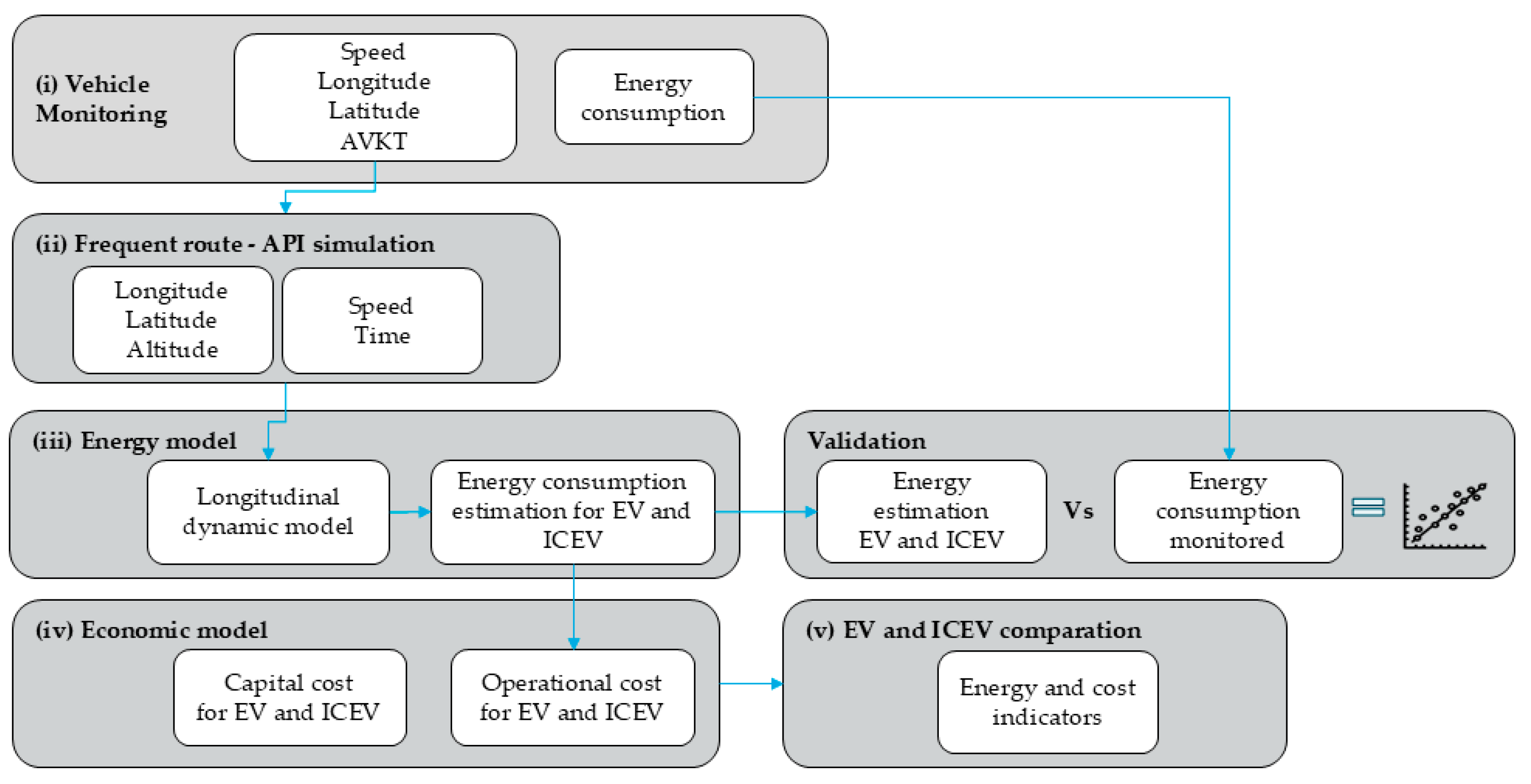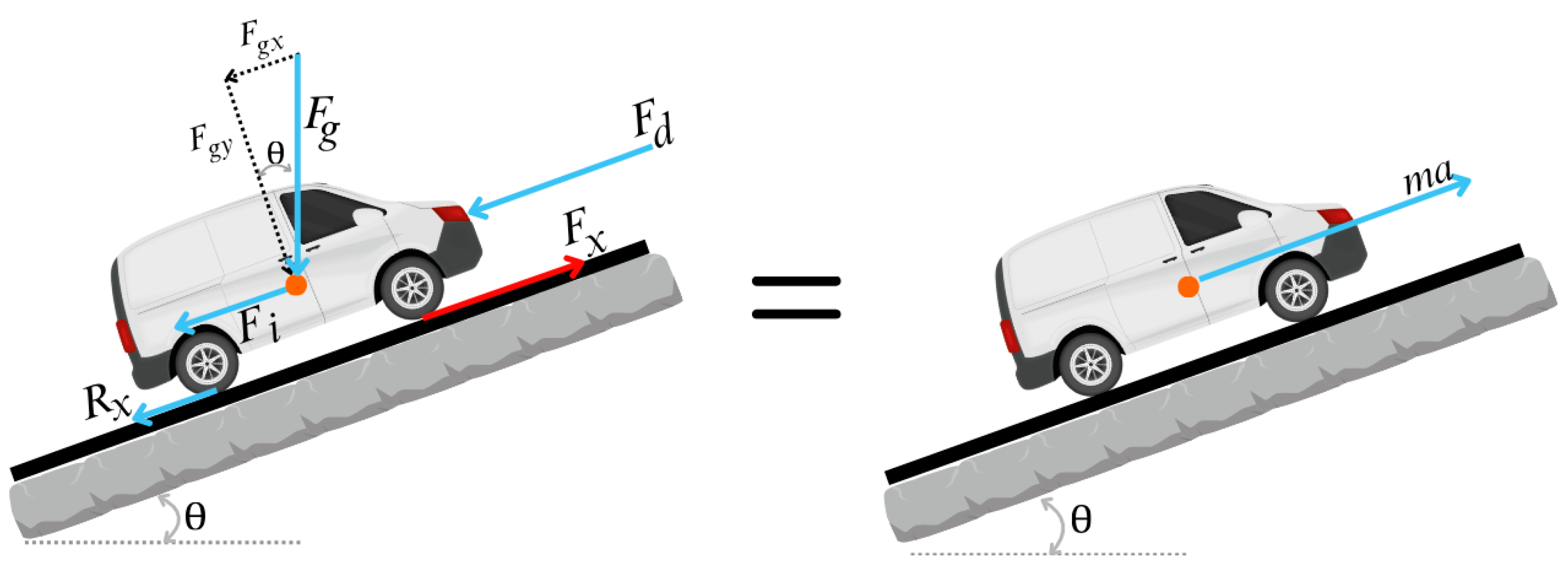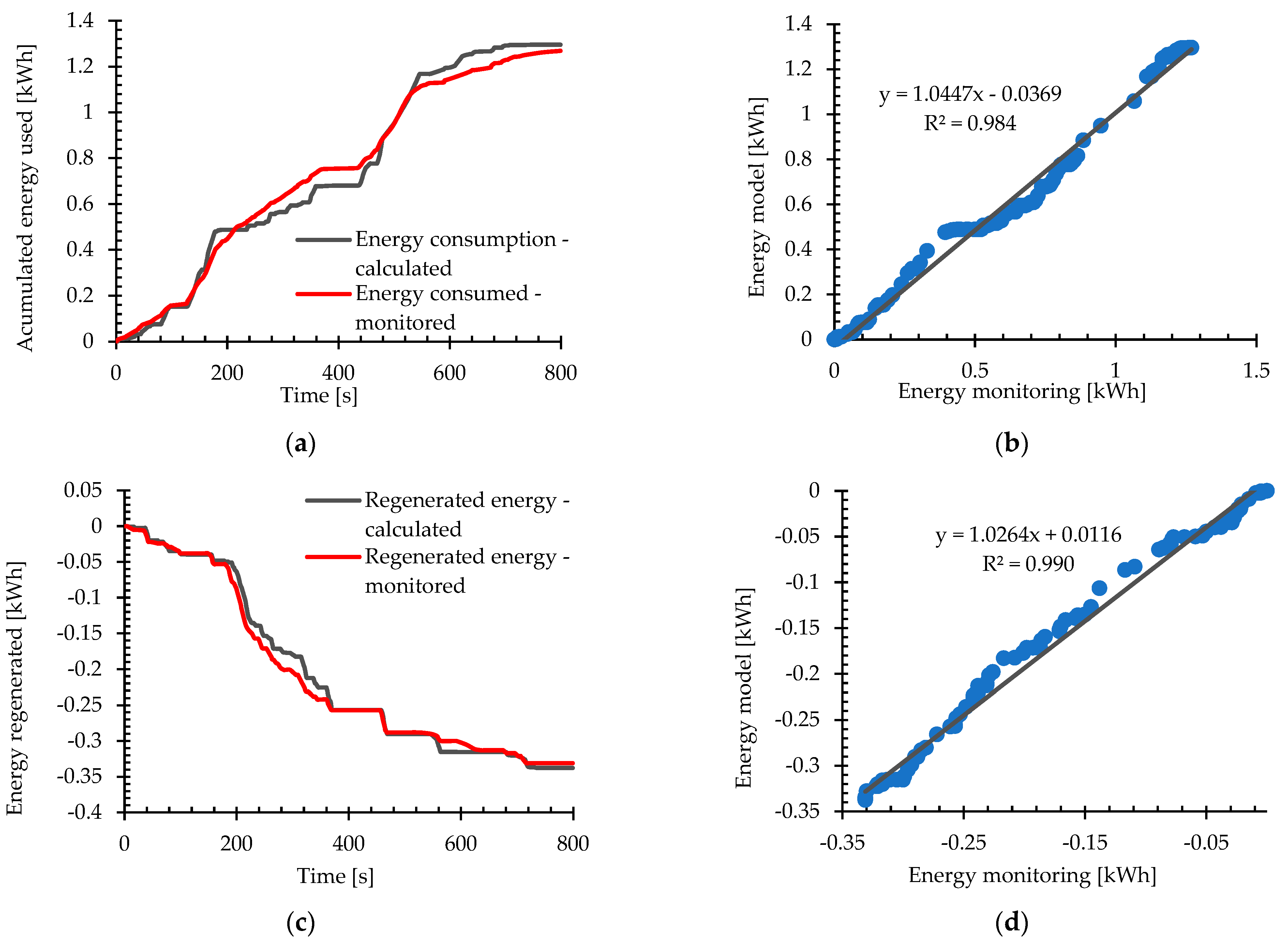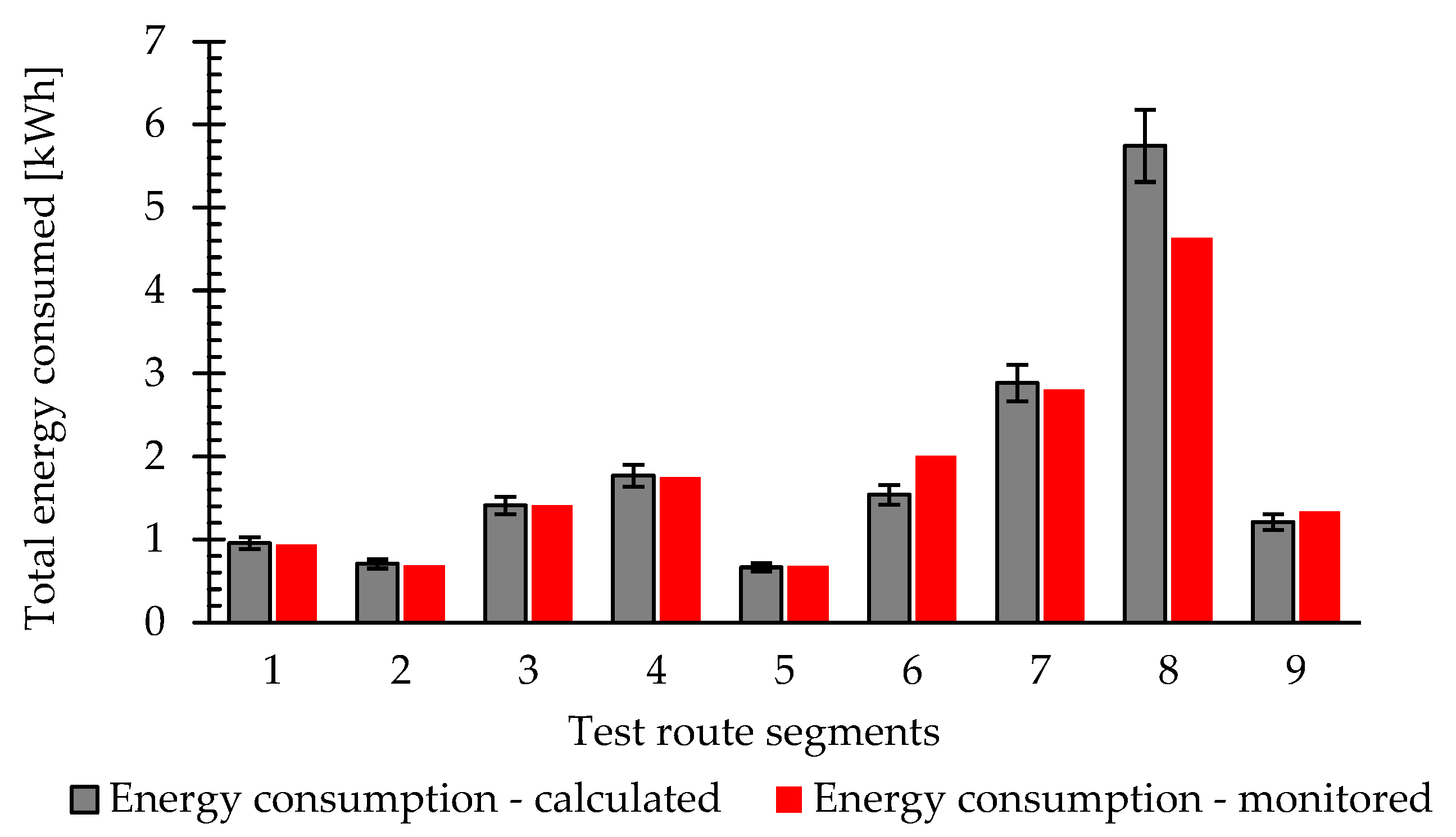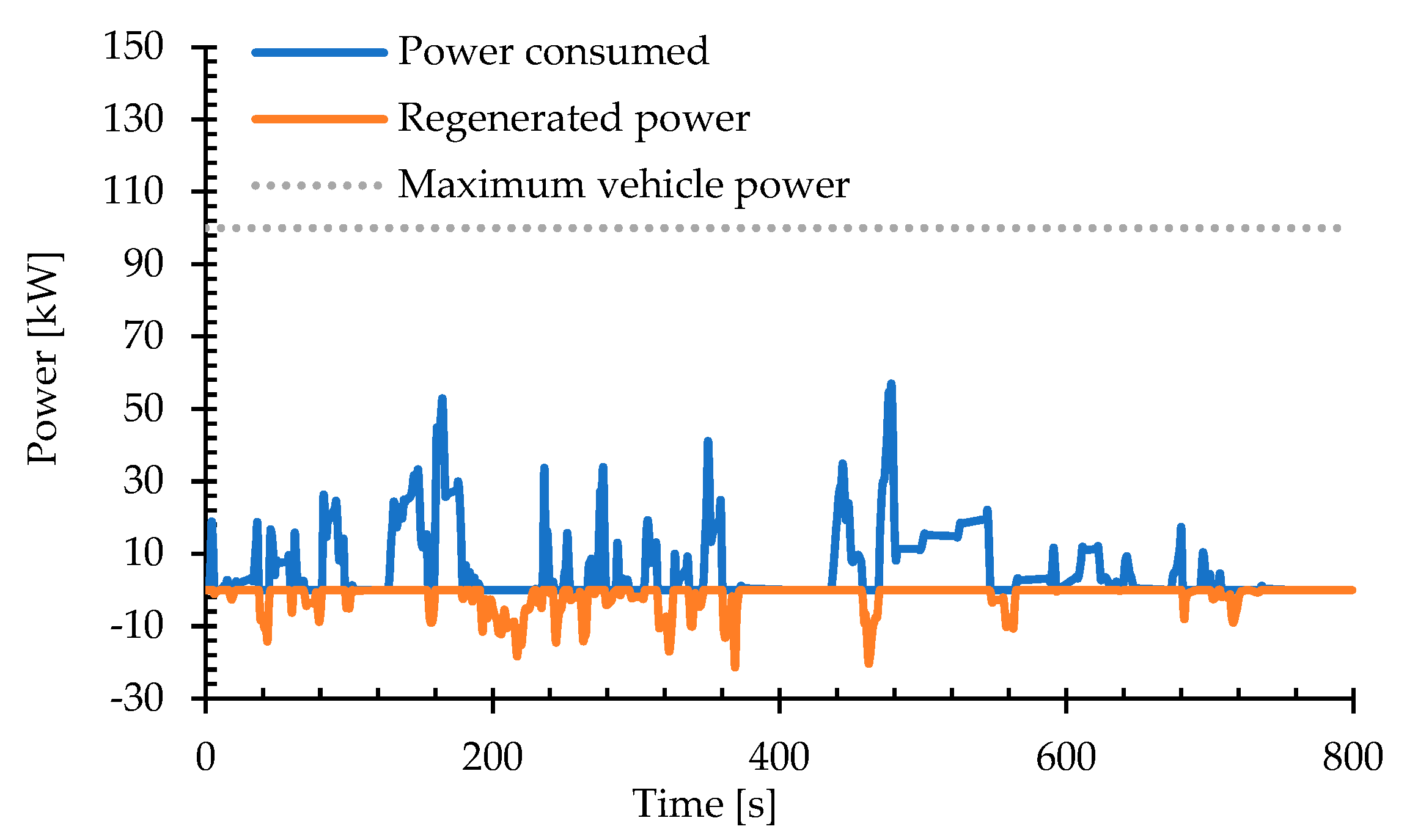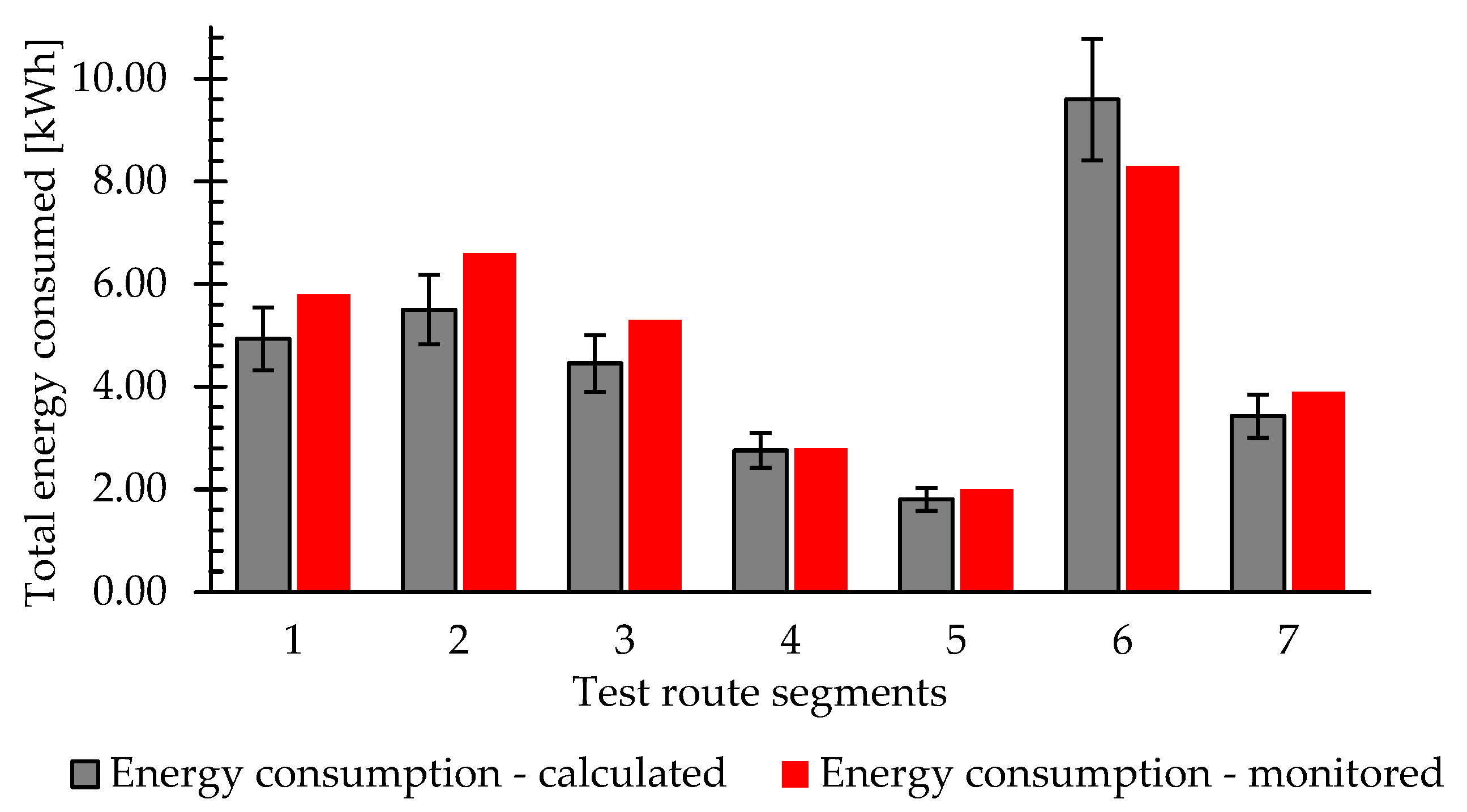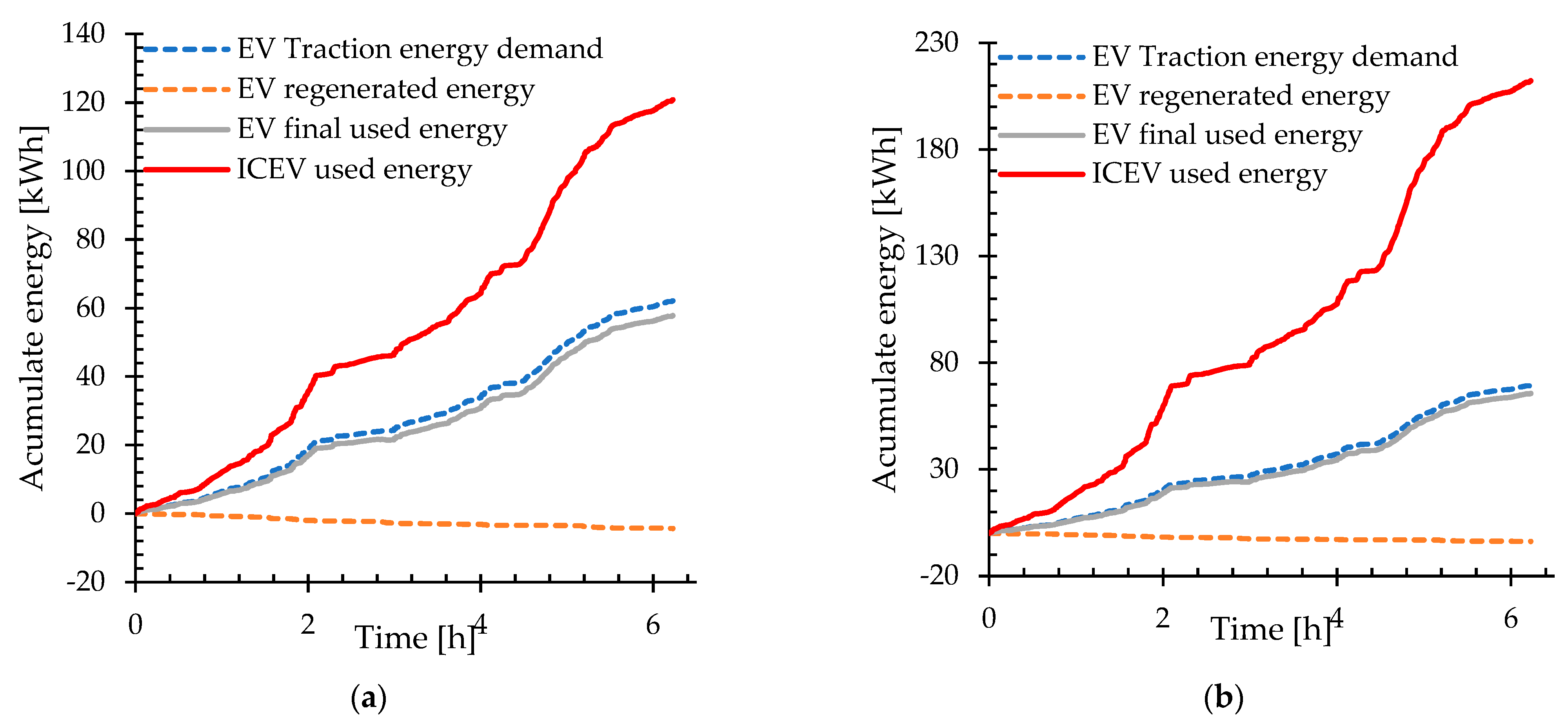Model validation is carried out using speed, time, and altitude parameters obtained from vehicle monitoring as input variables. The model’s output is then compared against the consumption-related measurements recorded during the monitoring process. The model is subsequently refined to minimize the average error between estimated and observed energy consumption. A 5% error margin is established as the threshold for considering the model highly reliable.
2.2. Energy Consumption Model
In this study, a model based on longitudinal vehicle dynamics was used to estimate fuel consumption. The model implements the fundamental laws of physics to calculate the longitudinal external forces represented graphically in
Figure 2.
The vehicle must overcome the forces opposing the movement. The required tractive force at the wheel can be calculated from Equation (1).
where
is the traction force required by the vehicle to perform the motion,
is the force caused by the aerodynamic drag,
is the rolling resistance,
is the longitudinal force caused by the weight of the vehicle considering the inclination and
is the inertial force of the vehicle including the inertia of the rotational elements used in the vehicle transmission. The forces are calculated by means of Equations (2)–(5) [
19].
where
is the air density,
is the frontal area of the vehicle,
is the aerodynamic drag coefficient,
is the vehicle speed,
is the rolling coefficient,
is the total vehicle mass,
is the road camber angle,
is the equivalent mass, which is composed of the total vehicle mass and the mass factor associated with the rotational components of the vehicle, and
is the vehicle acceleration.
The frontal area of the tested vehicles was estimated through planimetric analysis of photographs. For the vehicle typology used in the analysis, the aerodynamic coefficient ranges between 0.5 and 0.7 [
20]. The rolling coefficient depends on the tires of the vehicle and the road surface conditions.
Table 3 shows the ranges of this coefficient for different scenarios [
20].
The vehicles included in the study are fitted with conventional tires and transit mainly over asphalt roads, so a coefficient of 0.02 was used [
20]. The inertia force experienced by the vehicle in response to changes in speed is studied in terms of both translational and rotational kinetic energy. Inertia increases the vehicle’s effective mass due to the angular moment of rotating components. This equivalent mass
is estimated using Equation (6), which considers a dynamic inertia factor [
20].
where
NTD is the final drive ratio of the vehicle; it is the result of the product of the differential ratio and the vehicle gear ratio in each gear. The EVs under study have automatic transmissions and feature a Continuously Variable Transmission (CVT). The power requirement is estimated by means of Equation (7).
where
is the combined efficiency of the powertrain elements, which must be compensated to generate the required power.
There are conditions in which the resultant tractive force is negative. This is because the inertia force and the force due to the inclination gradient both contribute to the longitudinal motion of the vehicle. The instantaneous energy consumed by a vehicle engine can be estimated by Equation (8).
For the study, the energy consumed is determined in small segments with constant time intervals, where
is equal to 1 s, so it must be converted to hours using the factor of 3600. The total energy consumed during a trip can be estimated as shown in Equation (9).
where
represents the time, in seconds, that took the vehicle to complete the route. Currently, some vehicles feature a regenerative braking system that allows them to recover a portion of the energy. This system enables remnant kinetic energy from braking stages to be transformed into electricity, then used to charge the battery [
20].
A direct correlation exists between traction power and the energy recovered through regenerative braking. When traction power is positive, it means that the vehicle’s tires receive energy from the propulsion system to generate vehicle motion, thus making the braking energy null. On the other hand, traction power is negative in braking stages, and a fraction of the energy is recovered to the battery [
20]. Regenerative power is calculated through Equation (10).
where
is the combined efficiency for energy regeneration, and
is the regenerative braking factor. The combined efficiency is given by powertrain components and is one of the main differences between ICEVs and EVs.
For both ICEVs and EVs, the engine-to-tire transmission efficiency, as well as the engine’s efficiency, are taken into account. The electrical engine’s efficiency can be up to 95%, while the internal combustion engine does not go over 35% [
36].
Figure 3 showcases an EV’s combined efficiency, which is given by Equation (11).
where
is the transmission efficiency,
is the mechanical efficiency of the engine,
is the efficiency of the inverter, and
is the battery discharge efficiency.
When the electrical engine acts as a generator, a charging circuit converts electrical energy into chemical energy stored within the batteries. Taking the latter into consideration, the combined efficiency is modified as shown in Equation (12).
where
is the battery’s charging efficiency.
The regenerative braking coefficient
is related to the vehicle speed and can be estimated as shown in Equation (14) [
19].
It is worth noting that when a vehicle’s deceleration exceeds 0.2 times gravity, the security system that maintains vehicle stability is activated. This system distributes energy throughout the conventional braking system, therefore preventing regeneration [
36].
Regenerated energy from the vehicle’s braking system is calculated at one-second intervals, as shown in Equation (14).
Similarly, a vehicle’s total regenerated energy in its route is determined by Equation (15).
Taking into account the regenerated energy, total consumed energy can be represented through Equation (16).
where
is the energy recovered through the vehicle’s braking system. This parameter becomes non-zero when the traction force (
) is negative, enabling energy recovery. The regenerated energy mathematically originates from
and has an opposite sign to the tractive energy (
), making the magnitude of
equal to or less than
. ICEVs do not have a regenerative braking system, thus making the recovered energy zero.
Monitoring data is used to validate the model. For that purpose, preliminary model results are obtained in short segments and compared with energy registered during monitoring. If the consumed and regenerated energy error margin surpasses 5%, efficiency and regeneration factor parameters are adjusted.
Various web applications are used to simulate a route, which includes strategic locations for the operation of the electric vehicle fleet. Google API allows the recreation of frequent routes by joining the operational hubs and segmenting the route according to changes in direction, stops, control points, and critical areas. This web application provides the distance and travel time for all segments. Each data point in the partition is georeferenced, allowing the integration with Open-Elevation API to obtain road altitude. Route speed and elevation are filtered and smoothed before being sent to the model as primary inputs. By using web applications to recreate a route, no monitoring is required, thus expanding the possible usages of the energy consumption model. Finally, after validating the model, energy consumption is evaluated on the frequent route to assess the transition from a fleet of 10 ICEVs to 5 vans and 5 electric pickups.
2.3. Economic Model
In this study, the Total Cost of Ownership (TCO) model is implemented, which incorporates governmental incentives, retailer discounts, and regulations that grant tax benefits such as a reduced Value-Added Tax, as well as a lower vehicle tax, from 3.5% to 1%, for EVs. To estimate and forecast costs, two scenarios are considered: the first scenario involves no battery replacement within a 10-year timeframe, and the second scenario includes the replacement occurring during the 8th operation year of a 15-year ownership horizon.
The TCO for the studied vehicles in a base year, 2024 in this case, is calculated through Equation (17) [
12].
where
CC is the cost of capital, and
CO is the operating cost of the vehicles. The values used for every
component are estimated based on the company’s information and secondary sources, such as government entities and car dealership websites [
6,
37]. The cost of capital is calculated through Equation (18).
where
PV stands for the commercial price of the vehicle, and
VR represents the resale value at the end of its lifetime.
D denotes discounts offered by car dealerships, which may include exclusive offers or reductions for large purchases, while
CM represents the registration cost of the vehicle [
12]. Equation (19) is used to calculate the resale value.
where
is the depreciation value, considered at 20% for EVs in this study, taking into account the accelerated depreciation as one of the incentives given by the Colombian government. This depreciation occurs within the first 5 years of vehicle ownership, and
n is the analysis year [
38]. For ICEVs, depreciation is constant at 7% until the end of the analysis timeframe [
39]. The parameter
n corresponds to the analysis year in which the vehicle is projected to be sold; therefore, the analysis year is equivalent to the vehicle sales year in this context. Meanwhile,
represents the interest rate used to discount future cash flows to their present value. For this study, a 6.75%
rate is considered, corresponding to the average Consumer Price Index (CPI) between 2020 and 2024 [
40,
41].
The operational cost is calculated with Equation (20).
where
represents the vehicle maintenance and operation cost. In this case, 18% of the capital cost is assumed as the
for ICEVs [
38]. The EV maintenance cost is assumed to be 50% of the ICEV maintenance cost [
40].
CS represents the cost of the Mandatory Traffic Accident Insurance (Seguro Obligatorio de Accidentes de Tránsito, or SOAT), including a 10% discount for EVs in accordance with Law 1964 of 2019 [
6].
corresponds to the annual interest fee in the case of purchase financing, whether for an ICEV or an EV.
represents the vehicular taxes that must be paid annually.
refers to the cost of the energy used by the EV and the fuel consumed by ICEV on route. Equation (21) presents the latter, taking into account the vehicle kilometer traveled (VKT) and the predicted performance.
where
stands for the average annual kilometers traveled by a vehicle, and
is the fuel consumption [L/km] for ICEVs or energy consumption [kWh/km] for EVs. Finally,
refers to the energy cost in [COP/kWh] for electrical energy and [COP/L] for fuel.
The last component from Equation (20) corresponds to the Net Present Value formula, with which operational costs are estimated for a period n of analysis, and COP is calculated for the base year, which in this case is 2024.
The input values used to estimate EVs and ICEVs capital and operational costs are presented in
Table 4.
Once the costs of capital and operating costs are estimated, Equation (17) is used to calculate the TCO. However, this study is not limited to estimating the cost in the base year, but also analyzes the evolution of cost over 15 years, comparing the cost of EVs and ICEVs. The model also accounts for the depreciation of the vehicle over the holding period to assess the variance in the cost of capital.
The above is achieved by calculating the annual costs from 2024 to 2030. To estimate the cost of capital in each year (
CPC), Equation (22), is used, where the estimated cost of capital in the base year is used and depreciated according to the percentage
. In this way, the depreciation value of the vehicle during its useful life is discounted.
On the other hand, for calculating the operating costs (
OPC) of the vehicle on a year-by-year basis over their useful lives, Equation (23) is used, where the value of the operation in the base year CO is taken and then discounted over time. This formulation provides a simplified financial adjustment using a one-period linear approximation to incorporate the time value of money. While based on conventional discounting practices, it represents a modeling choice that balances analytical simplicity with capturing the discount rate’s impact on operating costs.
Finally, the cost model serves to evaluate the transition of 10 ICEVs from the fleet to 5 electric vans and 5 electric pickups.
